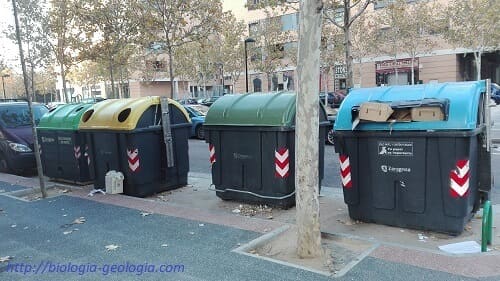Solid waste
Types of solid waste
- Solid urban waste. They are those generated in urban and domestic activities. They are very varied: paper, organic matter, plastics, glass, metal, containers, batteries, etc.
- Agricultural, livestock and forestry waste. Generated by these activities: organic remains, fertilizers, pesticides, fertilizers, slurry, pruning remains, wood, sawdust, etc.
- Sanitary waste. They are those from medical activities, produced by hospitals and laboratories, such as biological remains, syringes, medicines, gauze, X-rays, etc.
- Industrial waste. Originating from industrial activities, they are very varied, such as oils, scrap metal, solvents, paints, acids, etc.
- Radioactive waste. They come from nuclear power plants and from other places that use radioactive materials, such as hospitals and research laboratories. It is necessary to store them in very safe and protected places.
Each person in Spain generates an average of more than 400 kilos of waste per year that accumulates in landfills.
Solid waste problem
The main problem with solid waste is the large amount produced, since landfills collapse or, if incinerated, pollute the air. Additionally, rainwater can carry pollutants into nearby aquifers. They can also cause discomfort from the odors that are produced.
Hazardous waste has another problem, since it has to be stored in suitable landfills that are well sealed to avoid risks due to its toxicity.
If the waste has been abandoned in uncontrolled landfills, in addition to the visual impact it can contaminate the soil and water.
Solutions to the problem of solid waste
Society can act against the problem of solid waste by taking basic measures, commonly known as the "law of the three R's", which are:
- Reduct. It is about reducing the amount of waste we produce. It is the most sustainable option to avoid the problem of waste. We can reduce waste by turning off the light when it is not necessary, using reusable bags when we do the shopping, avoiding unnecessary packaging, showering instead of bathing, etc.
- Reuse. Before throwing away something that no longer serves us, we can think about how it can be used again. Thus we reduce the amount of waste. For example, reusing plastic bags or sheets of paper that are used for only one side.
- Reciclar. If it cannot be reused again, these residues can be used to obtain other materials that are used again. For example, paper, metal, or glass can be recycled and have new uses, and are cheaper than non-recycled ones.
For these measures to be carried out, awareness campaigns and environmental education are necessary that, in addition to correct legislation, allow both industries and individuals to collaborate against this problem.
Solid waste impacts
The large amount of solid waste that is generated makes its elimination difficult, which is why it accumulates in the environment and generates some environmental impacts:
- Soil contamination.
- Contamination of aquifers by leachates.
- Surface water pollution.
- Air pollution if incinerated uncontrollably.
- Visual impact spoiling the landscape.
- Bad smell in the immediate vicinity.
- Creation of infectious foci, if rodent and insect pests proliferate.
